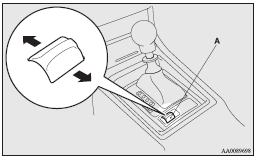Twin Clutch SST control mode
When the ignition switch is set to the “ON” position, operate the Twin Clutch SST control mode switch (A) to change the control mode.

When the engine is started, the control mode is automatically set to the “NORMAL” mode. Use the following procedures to change the control mode.
To shift from “NORMAL” mode to “SPORT” mode
While the vehicle is stopped or being driven, push the Twin Clutch SST control mode switch forward.
To shift from “SPORT” mode to “NORMAL” mode
While the vehicle is stopped or being driven, push the Twin Clutch SST control mode switch rearward.
![]() Note
Note
► If the Twin Clutch SST control mode switch is continuously pushed after a control
mode has been selected, an erroneous operation prevention function operates and
the control mode is automatically set to the “NORMAL” mode.
If you would like to select a control mode again, return the ignition switch to
the “ACC” or “LOCK” position and restart the engine. Then, push the Twin Clutch
SST control mode switch.
See also:
Chassis number
The chassis number is stamped on the bulkhead as shown in the illustration. ...
Emergency towing
If towing service is not available in an emergency, your vehicle may be temporarily
towed by a rope secured to the towing hook.
If your vehicle is to be towed by another vehicle or if your vehicle ...
